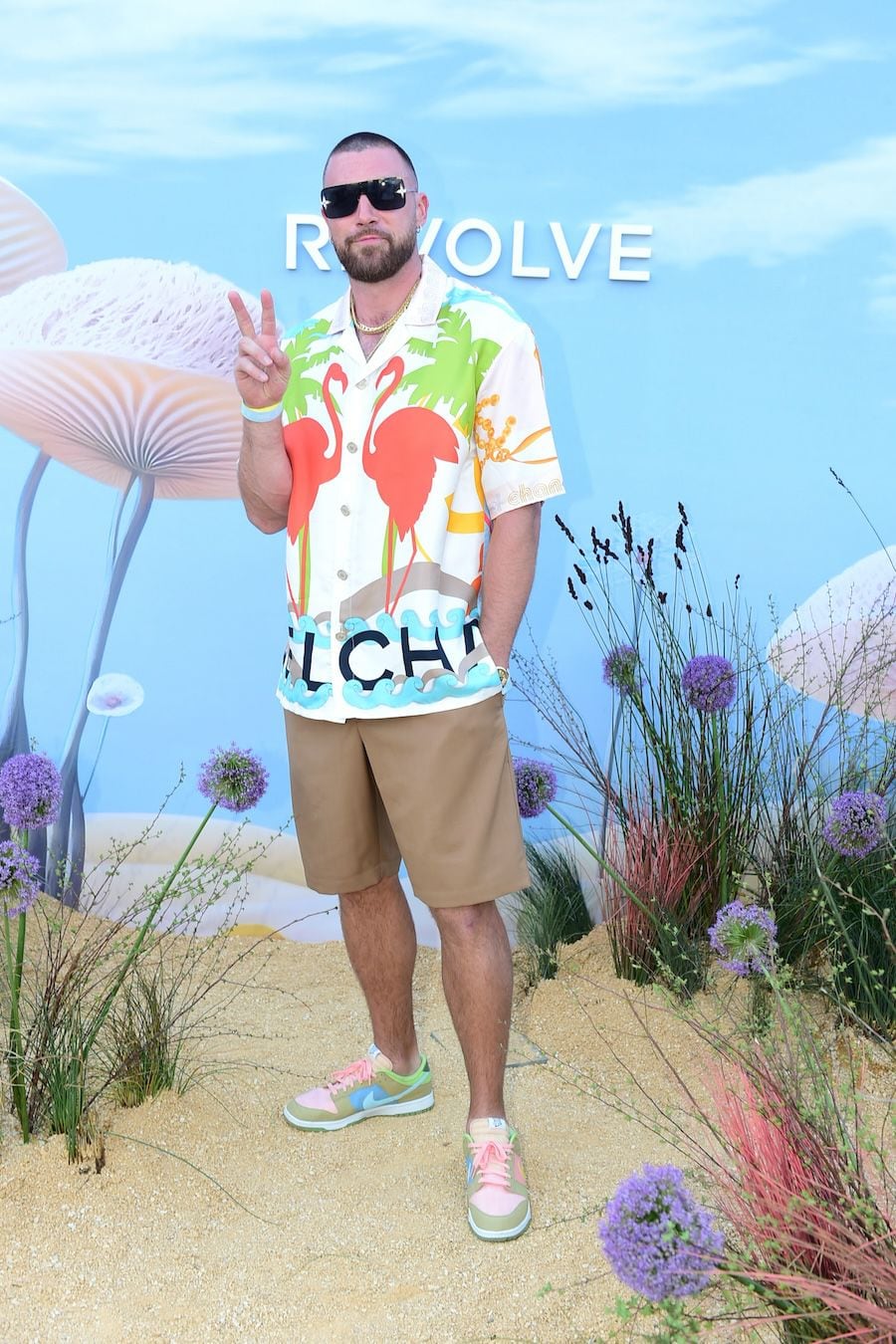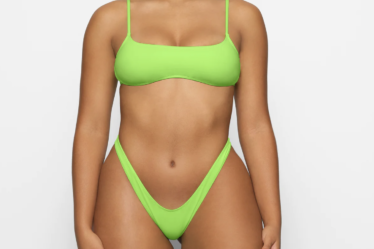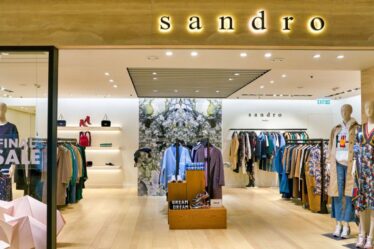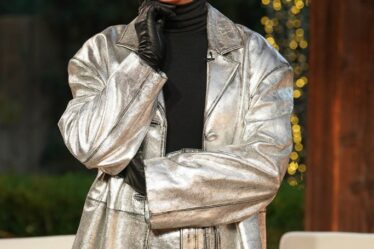
A little over a year ago, Travis Kelce, the American football star and boyfriend of Taylor Swift, stepped out in a flamboyant silk shirt emblazoned with two barrel-chest-sized pink flamingos and trimmed across the bottom with a giant Chanel logo.
The design was upcycled from vintage Chanel scarves by stylist Logan Horne, whose brand, J. Logan Home, specialises in refashioning heritage luxury accessories. His pieces, which retail at close to $3,000 each, have been worn by musicians Dua Lipa and 2 Chainz and sold at stores including Farfetch, Kith and The Webster. They’ve also caught the attention of the French luxury giant’s legal department.
In February, lawyers acting for Chanel sent Horne a cease and desist letter, demanding his label stop selling products bearing its logo and other brand signifiers.
It’s the latest in a flurry of cases that have turned upcycling into an emerging legal battle ground, pitting a practice that’s been pitched as key to improving the industry’s sustainability credentials against the established bounds of trademark protection.
“We really have these two values that point in different directions,” said Fashion Law Institute founder Susan Scafidi. “[Upcycling] is absolutely risky, despite the fact that it is trending and ethical.”
Why is upcycling so controversial?
Chanel’s objection to J. Logan Home’s designs isn’t exactly a bolt from the blue.
Major luxury players have historically been wary of the secondary market, concerned it could damage their carefully controlled hold on brand distribution and image, cannibalise sales and encourage counterfeiting.
It’s a tension that has played out prominently over the last decade thanks to the rapid rise of online resale platforms. Though some brands have begun to tentatively embrace the space, others have remained cautious. Chanel, in particular, has pursued high-profile cases against re-commerce players it argues are using its brand without permission and selling fakes.
(The brand scored a major win earlier this year, when a New York court awarded it $4 million in damages in its suit against the resale business What Goes Around Comes Around. A separate legal dispute with The RealReal is ongoing).
Smaller-scale upcycling has attracted less public attention so far. But the practice has become more widespread, driven in part by demand for logo-heavy streetwear, tech-enabled access to vintage products and deadstock fabrics and a growing desire among young designers to operate sustainably.
That’s given rise to an increasing number of trademark and copyright infringement complaints targeting upcyclers from brands including Louis Vuitton and Levi’s, as well as Chanel.
In 2022, Louis Vuitton secured a $603,000 pay out and permanent injunction in a Texas case against a business selling refashioned Vuitton products. Last year, Levi’s brought a complaint against French label Coperni, alleging it was using confusingly similar pocket stitching and fabric tabs to the famed denim label. The sale of such products alongside items that had actually been upcycled from Levi’s jeans without authorisation created additional risk of consumer confusion, the company argued. Both brands declined to comment.
The claims are varied but ultimately boil down to concerns that third parties are free-riding on major brands’ valuable IP in ways that could risk confusing consumers, eroding primary sales and tarnishing or diluting carefully cultivated marks.
Does upcycling infringe on brands’ trademarks?
The disputes reflect legitimate trademark and copyright concerns, but they also raise questions over how far these protections should stretch when they conflict with broader sustainability goals, according to legal experts.
“It is a grey area within the law,” said Scafidi. “Brands absolutely have a legal leg to stand on. The question is how well-clad it is.”
The legal arguments break down like this:
In general terms, once a brand has sold an item, it becomes fair game to be resold or redistributed by third parties. But this principle, known as the first-sale doctrine or trademark exhaustion, may not apply if an item has been reworked or embellished, lawyers said.
Upcyclers can take precautions, like avoiding the prominent use of logos, or providing consumers with clear disclosures that reworked products are not authorised or affiliated with the brands they reference (an approach J. Logan Home adopted). But these steps still may not be sufficient to counter arguments of copyright or trademark infringement, according to lawyers.
And while the legal frameworks protecting companies’ intellectual property are well established, whether the sustainability benefits of upcycling should be weighed against these hasn’t really been tested.
“If we want to move from a linear to a circular economy, we need to upcycle,” said Irene Calboli, a professor of law at Texas A&M University. “The fact that intellectual property law gets in the way of those who want to upcycle or recycle is just wrong.”
Chanel said it is paying close attention to sustainability matters, pointing to its work with L’Atelier des Matières, which recycles unsold items and deadstock from luxury and premium brands.
“[Upcycling is] a positive trend that we continue to explore, and we have always been conscious of the need to strike a balance between protecting the rights of our brand and the rights of others to create and trade freely,” the company said in a statement. “However, the use of elements stamped with the Chanel logo is sometimes simply an unauthorised misappropriation of our trademarks … in such cases, we take the action we deem appropriate to protect our rights.”
The wider legal crackdown hasn’t only targeted brands making prominent use of logos either.
In a previous life, before she became a celebrated New York designer, Batsheva Hay worked as a copyright lawyer. So it was a shock when she found herself on the receiving end of a cease and desist letter from a large commercial brand over a short run of dresses made from deadstock fabric sourced from India. Though it bore no obvious logo, as it turned out, the print she used had been made for a bigger player who didn’t want to see it reproduced elsewhere.
“I was really humiliated and horrified because I thought it was some cool vintage fruit print and it turned out to be some kind of junky commercial print,” said Hay. Rather than take on the time and expense of fighting the case, she just took the remaining three dresses she hadn’t yet sold off her site.
What does this mean for the future of upcycling?
Horne says he can’t afford to fight Chanel, which has threatened to seek statutory damages of $2 million per mark, disgorgement of all profits and payment of its attorney’s fees if he doesn’t stop selling products carrying the company’s branding, according to a copy of the letter reviewed by BoF.
Instead, he said he’s looking at to pivot his brand while continuing to find creative ways to address the industry’s issues with waste and over-production. The dream would be an opportunity to officially collaborate with an established label on an upcycled collection.
“As much as I believe in my mission … I’m not trying to go bankrupt going to battle with Chanel,” he said.
Industry watchers say the current flurry of cases reflect a broader adjustment to emerging new models. Some big brands, like Prada, Gucci and indeed Levi’s, have already dabbled with upcycling collections and programmes of their own. Anna Foster, who runs the refashioned jeans brand E.L.V. Denim, has partnered with companies including Gabriela Hearst and The Outnet to help upcycle excess inventory. These days, she says she’s having about a conversation a week with brands interested in exploring collaboration, but the industry moves slowly.
Meanwhile, politics may be moving at a faster speed, creating different challenges for brands. Both consumers and policy makers are increasingly aware of the huge levels of waste generated by the fashion industry, with new regulations that would make brands more responsible for dealing with old clothes and excess inventory in the pipeline in both Europe and the US.
“We really are at an inflection point where we might have a result in court that is different from the result in the court of social media,” said Scafidi. “It’s that tension that really needs to be resolved.”
Disclosure: LVMH is part of a group of investors who, together, hold a minority interest in The Business of Fashion. All investors have signed shareholders’ documentation guaranteeing BoF’s complete editorial independence.



